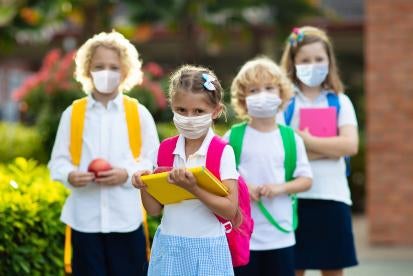Introduction: A National Strategy
Joseph R. Biden, Jr. was inaugurated as the 46th President of the United States on Jan. 20, 2021. As the COVID-19 pandemic continues to impact nearly every aspect of American life, President Biden has prioritized development of a comprehensive and effective COVID-19 response and pandemic preparedness plan. On his first full day in office, the President released the “National Strategy for the COVID-19 Response and Pandemic Preparedness.”[1] This plan provides, among other things, guidelines and implementation strategies for launching a nationwide vaccination campaign and mitigating the spread of COVID-19, with a goal of safely reopening businesses and schools across the country.
President Biden’s national plan acknowledges that, “Reopening schools, businesses, travel, and our economy will require major, unified federal investments in rapid testing, an expanded rapid response public health workforce, clear guidance and protections, and support for people to stay home when they are infected to stop the spread of COVID-19.” The National Strategy, in combination with President Biden’s Executive Order, “Supporting the Reopening and Continuing Operation of Schools and Early Childhood Education Providers[2],” sets forth a goal of safely reopening a majority of K-8 schools within 100 days. While the National Strategy lays out guidelines and expected protocols for the future, the fact remains that the success of many of its provisions will require Congressional approval and agency engagement. Details of the plan are still emerging, but initial information is provided below.
Safely Reopening Schools
The Biden-Harris Administration, in its National Strategy, acknowledges the myriad challenges schools, districts, and states have faced during the course of the COVID-19 pandemic. Students across the United States have lost months of critical learning as a result of school closures, and educators have been forced to adapt quickly to the ever-changing national landscape. Noting a lack of available testing and resources to operate safely, along with a lack of clear, consistent, data-driven guidance and best practices for safely keeping schools open, the National Strategy pledges a “whole-of-government effort” to ensure that schools that can open safely have the resources to do so, and that those that must remain closed have the support to do that, too.
Funding Support
K-12 schools will soon receive full access to Federal Emergency Management Agency (FEMA) disaster relief and emergency assistance. The Presidential Memorandum, “Extend Federal Support to Governors’ Use of National Guard to Respond to COVID-19 and to Increase Reimbursement and other Assistance Provided to States” restores full reimbursement for eligible costs necessary to support safe school reopening through the FEMA Disaster Relief Fund. In the coming weeks, state and local governments can expect collaboration between FEMA, the United States Department of Education (USDOE), and the Centers for Disease Control (CDC) to allocate and use increased funds to address barriers to reopening schools safely.
President Biden has also called on Congress to provide at least $130 billion in dedicated funding to schools, $350 billion in flexible state and local relief funds that will help districts avoid lay-offs and close budget gaps, and additional resources, including funds to implement screening testing. The Administration cannot unilaterally allocate these funds, however, and Congressional approval will be necessary before schools receive additional financial support. The funding is intended to allow schools and districts to implement regular COVID-19 testing, address transportation and ventilation needs, provide Personal Protective Equipment (PPE), hire more teachers to support reduced class size and social distancing, hire nurses and medical support staff, provide more counselors to address students’ social and emotional needs, and provide additional learning supports for students to address the systemic education gaps caused by the pandemic. Schools, districts, and state departments of education should identify and prioritize areas of need in order to most effectively use any additional funding for which they are approved.
COVID-19 Testing and Vaccination Implementation
The National Strategy observes that regular COVID-19 testing is a “key component” of the national plan to safely reopen schools. Schools, Local Educational Agencies (LEAs), and State Educational Agencies (SEAs) can expect federal support as they purchase rapid tests and expand laboratory capacity as needed. Further, the federal government will provide “testing support teams” to help schools develop plans for regular COVID-19 testing. These support teams will assist schools in navigating federal and state requirements, obtaining consent for testing, administering sample collection, and contact tracing. The National Strategy aims to provide COVID-19 tests and other necessary supplies equitably to support safe school reopening, although success of this portion of the National Strategy will largely depend on the logistical infrastructure in place across various communities.
As is the case with the testing protocols endorsed by the Biden Administration, the National Strategy’s emphasis on providing teachers and school staff with prioritized access to the COVID-19 vaccine will be subject to pragmatic challenges. Ensuring that communities receive adequate quantities of the vaccine and enough trained medical professionals to administer the shots may prove just as challenging as obtaining enough testing kits, swabs, reagents, and lab capacity to analyze results. Details regarding the process of translating funding into tangible assistance to schools and districts have not yet been released, but should be expected.
Detailed Technical Guidance
The USDOE, in conjunction with the CDC, will release a handbook that helps schools and local leaders implement the precautions and strategies necessary for safe school reopening. Although this handbook is not yet available, it can be expected in the coming weeks and will address such topics as:
-
Utilizing PPE and other necessary supplies;
-
Implementing COVID-19 mitigation measures like physical distancing and cohorts;
-
Improving ventilation;
-
Increasing staffing;
-
Responding to outbreaks;
-
Using surge testing and contact tracing to control outbreaks;
-
Implementing isolation and quarantine protocols;
-
Serving and accommodating students and staff who are immunocompromised or have disabilities/special needs; and
-
Addressing other issues identified by state and local health departments and their education counterparts.
State and local educational agencies can also expect collaboration between the USDOE and the United States Department of Health and Human Services (HHS) to provide guidance on reopening for in-person learning and how to remain open. Both agencies will submit a report to the White House on strategies to address the impact of the pandemic on educational outcomes, especially along racial and socioeconomic lines.
Safer Schools and Campuses Best Practices Clearinghouse
The President’s recent Executive Order calls for developing a Safer Schools and Campuses Best Practices Clearinghouse to share lessons learned and best practices across the country. This Clearinghouse will allow districts to access information from other schools and states that have successfully maintained safe operations during the pandemic, especially as increased federal funding permits districts to implement different and potentially effective strategies.
Progress Tracking
The federal government will undertake a national data tracking effort to collect and share data on school reopening efforts at the school, district, and state levels. The National Plan notes that a lack of data on the status of school openings and closures leaves policy makers and the public in the dark about the true impact of school closures and, specifically, the effects on low-income students and students of color. Increased data collection and publication efforts will assist the Administration in identifying and addressing challenges related to education equity. This information could also become a vehicle for compliance and enforcement by state and federal officials.
Supporting All Forms of Learning
While the Biden Administration’s goal is to safely reopen a majority of K-8 schools within 100 days, the National Strategy acknowledges that some students and educators will not be able to return to in-person learning safely. Local spikes in the number of COVID-19 cases or personal and family health issues will prevent the entire education community from returning at once, and the federal government has pledged to continue to prioritize learning for those who must remain remote. Schools and districts can expect guidance from the USDOE on how best to conduct distance learning as well as how to address the learning loss that occurred over the last several months.
The President will work with Congress to address funding and support of educational entities to provide high-quality distance learning, including technology, tech support, broadband access (with assistance from the Federal Communications Commission), additional staffing, and other necessary resources. The message is clear: whether students are learning in-person or remotely, students must receive quality, consistent education. As the President’s Executive Order emphasizes, “every student in the United States should have the opportunity to receive a high-quality education, during and beyond the pandemic.”
Conclusion
While the hope is that the rollout of a nationwide vaccination initiative will eventually temper the COVID-19 pandemic, schools and districts across the country are still reeling from abrupt school closures and the difficult transition to distance learning. While there is no question that the pandemic has greatly altered the American education system, the federal government has signaled its purported commitment to implementing a national strategy to support safely reopening schools. Educational institutions should expect increased funding and support in order to access critical supplies and implement comprehensive COVID-19 testing protocols, and federal agencies will soon release detailed guidance to assist in the national reopening effort. Portions of President Biden’s National Strategy may go into effect immediately, while others will require substantial collaboration and approval from other agencies or branches of government.
[1] Available at https://www.whitehouse.gov/wp-content/uploads/2021/01/National-Strategy-for-the-COVID-19-Response-and-Pandemic-Preparedness.pdf






 i
i


